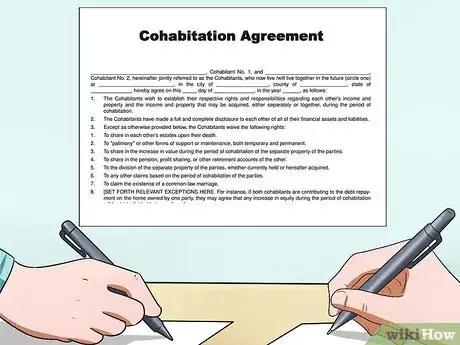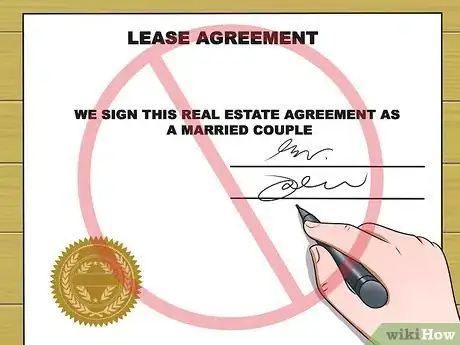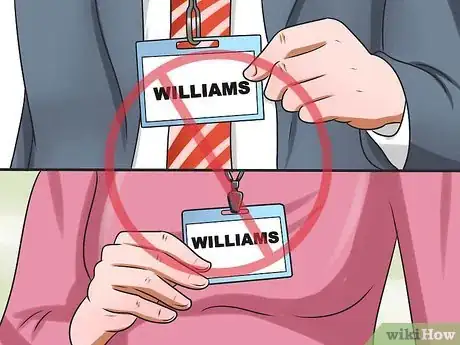This article was co-authored by Clinton M. Sandvick, JD, PhD. Clinton M. Sandvick worked as a civil litigator in California for over 7 years. He received his JD from the University of Wisconsin-Madison in 1998 and his PhD in American History from the University of Oregon in 2013.
There are 8 references cited in this article, which can be found at the bottom of the page.
This article has been viewed 175,652 times.
In Texas, a common law marriage arises when a couple: (1) agree that they are married; (2) live together in Texas as husband and wife; and (3) hold themselves out as being married.[1] Marriage entails certain legal rights and responsibilities, and can impact your rights in the division of property upon divorce or separation. For example, at the end of a relationship, one partner might assert that the parties were in a common law marriage and claim a share of the other partner's property under Texas's community property laws. You and your partner can take steps to avoid the presumption that you are in a common law marriage.
Steps
Avoiding an Agreement to be Married
-
1Talk with your significant other about your relationship. Communicate with your significant other and make sure you both understand the limits of your relationship. You and your significant other should both have the understanding that there has been no agreement made to be married. You should also communicate the following circumstances with your partner, as they will affect your ability to be involved in a common law marriage:
-
2Do not file any common law marriage documents with a Texas court. You and your partner should avoid filing certain documents with a Texas court, and you should avoid asking a Texas court to recognize a common law marriage. Doing so will result in the state recognizing a common law marriage. The important documents you should avoid filing and the proceedings you should avoid are:
- A Declaration of Marriage. This is a document that formalizes a common law marriage.[4] It may also be referred to as a Declaration of Informal Marriage.[5] This document asks you to fill out, sign, and date a declaration stating that you meet all of the requirements of an informal marriage.
- A Recognition of Common Law Marriage. This is a type of proceeding before a judge whereby you ask the court to recognize a common law marriage for a specific purpose, such as when you are filing for divorce.[6] When you go to the court hearing, you will most likely have to fill out a declaration of marriage form and file it with the court.
- Agreements signed as a married couple. You should also avoid filing any documents with a court that have been signed by you and your significant other as a married couple.[7] Examples include leases, life insurance policies, and tax returns.[8]
Advertisement -
3Sign a cohabitation agreement. You and your partner should draft and sign a cohabitation agreement, which is a document that specifies your rights as a couple and safeguards each person's individual interests and assets.[9] The agreement should include a section that clarifies your relationship status and states that you are not agreeing to be married.
- A cohabitation agreement should include sections on how household expenses and property accumulated during the relationship will be split; and set forth procedures for a breakup.[10] Within this agreement, include a provision stating: "Our relationship shall not be construed as a common law or informal marriage, and by living together and holding ourselves out as being a couple we are not agreeing to be married."
- The Texas legislature has not specifically addressed the legal issues surrounding cohabitation agreements, but they are likely to be upheld in court as valid contracts.[11] Apart from those requirements, an enforceable cohabitation agreement is just like any other contract and must conform to your state's contract laws.[12]
Choosing Not to Live Together as Husband and Wife
-
1Consider living with your significant other only when you are ready to be married. Without evidence to the contrary, living together can be construed by others as evidence that you and your significant other are married.
-
2Understand how you should sign a lease agreement, purchase and sale agreement, deed, or mortgage. When you and your significant other decide to live with each other, you both need to make sure you do not sign any document as husband and wife. In order to make sure you are not living together as husband and wife, never sign a real estate agreement that contains the following language:
- "Husband and wife."
- "Mr. and Mrs. [followed by one of your last names]."
- "We sign this real estate agreement as a married couple."
-
3Talk with your landlord or real estate agent and make your relationship status known. When you and your partner move in together, make sure you discuss your relationship status with your landlord or your real estate agent and make clear that you are not a married couple.
Holding Yourself Out as Unmarried
-
1Sign documents carefully. When you and your partner sign documents together, make sure you are not signing them as a married couple. Always sign the following documents as an individual, or as a pair without portraying your relationship as a marriage:
- Real estate documents.
- Life insurance policies.
- Credit applications.
-
2File your taxes separately. Your relationship status plays an important role in filling out tax forms. If you file jointly with your significant other, the government may review your tax return as if you are married. If this is the case, the government will then have direct evidence of you holding yourself out as married. You should always file separately until you are ready to be married.
-
3Do not open joint bank accounts or get joint credit cards. Opening up joint accounts is a clear indication of your relationship status. Having a joint account is likely not enough to hold yourself out as married, but it will certainly be strong evidence to that effect. If you really want to share your money, consider sharing cash you both pool together.
-
4Do not use your significant other's last name. Using your partner's last name is a clear indication that you are holding yourself out as being married. Taking someone else's last name is usually reserved for marriage, and while doing so before you are married may be legal, it will certainly hurt your chances of not being seen as married. Not only will sharing a last name look like you are holding yourself out as being married, it will also confuse things with your legal documents such as your photo ID, passport, birth certificate, and social security card.
-
5Be aware of how you talk about your relationship with other people. When interacting with others in public, make sure you do not claim you are married. The following examples will give you a good idea of what not to do:
- When you move in together, do not tell your neighbors or house guests that you are a married couple.
- When you are at social gatherings, do not introduce your significant other as "your spouse."
-
6Watch how you and your significant other act on social media. You and your partner should not claim you are married on sites such as Twitter, Facebook, Instagram, or Snapchat. Doing so may be enough for you to be holding yourself out as married. For example:
- Do not create a relationship status on Facebook that says "married."
- Do not post a photograph on Instagram of you and your significant other with a caption that says "married" or anything else that could be construed that way.
- Do not tweet anything on Twitter that states you are married or that you are with your spouse.
Warnings
- This article is intended as legal information and does not provide legal advice. If you need legal advice, contact a licensed attorney.⧼thumbs_response⧽
- A common law marriage is enforceable in Texas the same way any other marriage in Texas would be. Therefore, if you are involved in a common law marriage and want to get divorced, you will have to go through formal divorce proceedings.[14]⧼thumbs_response⧽
- If you find yourself in a common law marriage and you have a child with your common law spouse, you may be required to provide child support and medical support to that child.[15]⧼thumbs_response⧽
References
- ↑ http://texaslawhelp.org/files/685E99A9-A3EB-6584-CA74-137E0474AE2C/attachments/D82134BE-C249-CFB5-6869-1BD25BA6E78F/407091LHT%2032_1%20Comm%20Law%20Marriage.pdf
- ↑ http://texaslawhelp.org/files/685E99A9-A3EB-6584-CA74-137E0474AE2C/attachments/D82134BE-C249-CFB5-6869-1BD25BA6E78F/407091LHT%2032_1%20Comm%20Law%20Marriage.pdf
- ↑ http://texaslawhelp.org/files/685E99A9-A3EB-6584-CA74-137E0474AE2C/attachments/D82134BE-C249-CFB5-6869-1BD25BA6E78F/407091LHT%2032_1%20Comm%20Law%20Marriage.pdf
- ↑ http://texaslawhelp.org/files/685E99A9-A3EB-6584-CA74-137E0474AE2C/attachments/D82134BE-C249-CFB5-6869-1BD25BA6E78F/407091LHT%2032_1%20Comm%20Law%20Marriage.pdf
- ↑ http://www.statutes.legis.state.tx.us/Docs/FA/htm/FA.2.htm#2.401
- ↑ http://texaslawhelp.org/files/685E99A9-A3EB-6584-CA74-137E0474AE2C/attachments/D82134BE-C249-CFB5-6869-1BD25BA6E78F/407091LHT%2032_1%20Comm%20Law%20Marriage.pdf
- ↑ http://texaslawhelp.org/files/685E99A9-A3EB-6584-CA74-137E0474AE2C/attachments/D82134BE-C249-CFB5-6869-1BD25BA6E78F/407091LHT%2032_1%20Comm%20Law%20Marriage.pdf
- ↑ http://texaslawhelp.org/files/685E99A9-A3EB-6584-CA74-137E0474AE2C/attachments/D82134BE-C249-CFB5-6869-1BD25BA6E78F/407091LHT%2032_1%20Comm%20Law%20Marriage.pdf
- ↑ http://family.findlaw.com/living-together/cohabitation-agreements.html
- ↑ http://family.findlaw.com/living-together/sample-cohabitation-agreement.html
- ↑ http://www.crossattorney.com/family-law/cohabitation-agreements/
- ↑ http://family.findlaw.com/living-together/validity-of-living-together-contracts.html
- ↑ https://texaslawhelp.org/article/common-law-marriage#toc-6
- ↑ http://texaslawhelp.org/files/685E99A9-A3EB-6584-CA74-137E0474AE2C/attachments/D82134BE-C249-CFB5-6869-1BD25BA6E78F/407091LHT%2032_1%20Comm%20Law%20Marriage.pdf
- ↑ http://statelaws.findlaw.com/texas-law/common-law-marriage-in-texas.html








































































